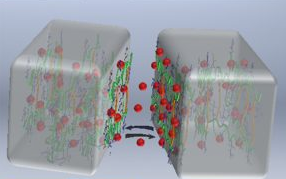Most self-healing materials so far have been designed to repair themselves in response to external stimuli such as light, temperature and electricity. These non-autonomous self-healing systems differ from living tissue in that they still need some form of intervention before they can heal, and the goal is to create materials that can fix themselves without any help. For that, conductivity is a key property. Autonomous conductive self-healing materials have been created, but they haven’t performed very well in practical applications due to lack of characteristics like stretchability, pressure sensitivity, bulk conductivity or overall mechanical performance.
“The autonomous intrinsic self-healing of the hydrogel is attained through dynamic ionic interactions between carboxylic groups of poly(acrylic acid) and ferric ions. A covalent cross-linking is used to support the mechanical structure of the hydrogel. Establishing a fair balance between the chemical and physical cross-linking networks together with the conductive nanostructure of polypyrrole networks leads to a double network hydrogel with bulk conductivity, mechanical and electrical self-healing properties (100% mechanical recovery in 2 min), ultrastretchability (1500%), and pressure sensitivity.”
A two-step process is used to prepare the hydrogel. Polypyrrole (PPY) is linked to double-bond decorated chitosan (DCh), forming PPy-grafted chitosan (DCh-PPy). Acrylic acid (AA) monomers are polymerized in DCh-PPy using iron ions, which produces the double network hydrogel. The autonomous self-healing properties of the material are produced by the reversible ionic interactions between the AA and the DCh-PPy.
As described in the paper’s abstract, the material is able to fully repair itself within two minutes, and it can also recover 90% of its electrical properties within 30 seconds, without any external stimuli. This autonomous healing ability, as well as shear thinning behavior, make the hydrogel an ideal material for 3D printing, according to the researchers, and potential applications include soft robotics, biomimetic prostheses, and health monitoring systems.
“The practical potential of CSH hydrogels is further revealed by their application in human motion detection and their 3D-printing performance,” the researchers add.
Authors of the paper include Mohammad Ali Darabi, Ali Khosrozadeh, Rene Mbeleck, Yuqing Liu, Qiang Chang, Junzi Jiang, Jun Cai, Quan Wang, Gaoxing Luo, and Malcolm Xing.
Discuss in the Self-Healing Materials forum at 3DPB.com.
[Source: Advanced Science News]
